Panasonic Viera TH-46PZ81 46in Plasma TV Review
Panasonic Viera TH-46PZ81 46in Plasma TV Review
From preview to review, the first UK TV with integrated Freesat tuner gets the once over from John.
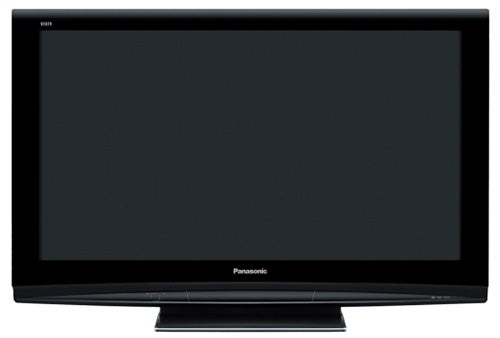
Verdict
Key Specifications
- Review Price: £1418.70
Rather handily, just as I was about to write this review Sky did something it seldom does: it dropped one of its prices. And that price, tellingly, was for its HD receiver, which, from July 1st, will be available to new and existing Sky subscribers alike for just £150 (vs the current price of £250).
Why use this information to kick off a TV review? Because it suggests – if not actually proves – that the recent launch of the Freesat service is proving enough of a success to cause at least a few ripples in the normally placid surface of Sky’s previously exclusive satellite broadcasting pond. And on the evidence of the first UK TV with integrated Freesat tuner, Panasonic’s TH-46PZ81, I can’t help but think that those ripples are only going to get bigger…
But I’m getting ahead of myself. For even though Riyad has thankfully made my job easier by doing an in-depth preview of this TV a few weeks back based on time spent with a preproduction model, there’s still a lot to get through.

For starters, as we said in our preview, the 46PZ81 is an attractive bit of kit, combining a gloss black finish with sleek lines. There’s not the overt, attention-seeking glamour of one or two of today’s ‘supermodel’ TVs, but if you prefer the strong, silent type, this Panasonic fits the bill.
Don’t forget, however, that the TV chassis is just part of the story, as you’ll also need to have a satellite dish installed on the outside of your home. If you already have a Sky dish then you’re laughing, as the Freesat service comes from the same satellites as the Sky service. If you don’t already have a dish, though, you’ll have to add £80 to the cost of the TV to get one installed.
The effort of getting a dish does, I have to say, cause me to question slightly Freesat’s claimed target market; namely all the people who haven’t yet ‘gone digital’ with their TV in any way at all. For it seems to me that anyone yet to at least get a Freeview box just can’t be interested in TV very much, and certainly won’t want to bother with getting a satellite dish put up to receive dozens of channels they couldn’t care less about.
But while I’m not sure Freesat’s right with its main marketing targets, I’m certainly not saying it doesn’t have a market. The fact that the Freesat receivers can work with existing Sky dishes certainly opens the door to lots of people ditching Sky’s expensive subs in favour of Freesat’s subscription-free offering. Plus, of course, there are many people out there who simply can’t receive a good Freeview signal, and so are crying out for a ‘free’ expansion of their channel choice. Riyad himself struggles to receive Freeview despite living in Surrey – hardly a provincial backwater!
Anyway, fascinating though all this background discussion is, it’s moved us slightly away from our focus: the Panasonic 46PZ81. So, getting back to business with its connections, the set does, of course, feature a satellite input. But crucially this is joined by a standard RF port connected to both analogue and digital Freeview tuners. The ability of the TV to handle Freeview as well as Freesat is actually quite important, as there are channels on Freeview that Freesat does not currently carry, such as Sky Sports News, E4+1 and, um, Nuts TV…
More jacks crucial to the TV’s digital tuner ambitions are a CAM slot for adding pay TV services (to the terrestrial digital tuner) such as Top Up TV; a digital audio output for piping out any Dolby Digital soundtracks that may be delivered via the Freesat channels; and an Ethernet port which will apparently come in handy for ‘future functionality’.
This functionality hasn’t been expressly laid out as yet, but as Riyad said in his preview of the TV, it’s distinctly likely that it will eventually allow you to view the BBC’s iPlayer service directly on the TV. Neat! However, the only pity with the Ethernet port is the fact that you can’t stream AV content through it from a connected PC.
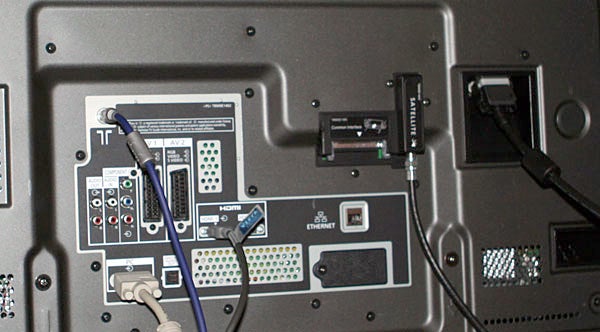
That’s not to say the set doesn’t have any multimedia potential, though. For as well as a D-Sub PC port, the set carries an SD card slot for playing both JPEG stills and AVC-HD video files (likely shot on a camcorder).
Also key among the 46PZ81’s connections are three HDMIs, all built to the v1.3 specification, with full x.v. Colour and Deep Color compatibility, and the facility – along with the TV’s Real Cinema processing – to handle 1080p/24 sources with reduced judder.
Real Cinema is far from the only video processing on the TV, mind you. It’s also got 100Hz to improve image stability, and even Panasonic’s high-end Intelligent Frame Creation system. This calculates the appearance of virtual ‘intermediate’ image frames between the real ones coming in from a source, rather than merely doubling the frame rate, so that motion can look more natural and fluid, and the picture can look crisper and more stable.
Let’s not forget, either, all the other bits and bobs delivered by Panasonic’s latest V-Real 3 processing, including enhanced detailing, and oodles of noise reduction.
The Z part of the 46PZ81’s name reveals it to be a Full HD model, with 1,920 x 1,080 pixels – just the job for perfect pixel-by-pixel playback of Freesat’s key HD services: BBC HD and the recently launched ITV HD.
Other very impressive specs up the 46PZ81’s sleeve are its native contrast ratio claims of 30,000:1, and dynamic contrast ratio claims of 1,000,000:1 – figures more than big enough to cause anguished tears to pour down LCD TVs’ permanently backlit faces!
The last feature we need to talk about before seeing how the 46PZ81 and its Freesat tuner work is its Freesat electronic programme guide. This has been designed by Panasonic (Freesat doesn’t dictate how its channel information is presented), and it’s hard to see how it could be presented much better. In effect it’s a slightly more extensive, less colourful version of the Freeview EPG, but with a Freesat Logo to the top left, and a touch more genre specificity.
Unable to resist, I started my tests off with a little HD from BBC HD. And boy, was I impressed. The Panasonic uses its Full HD resolution and terrific image processing engines to do an absolutely first rate job of rendering the HD footage with extreme sharpness, total pixel accuracy, and not a trace of noise beyond the slight grain that seems inherent to the BBC HD proposition these days.
In fact, I would say that the 46PZ81’s HD pictures are clearly better (cleaner, sharper) than those obtained by attaching an external Freesat HD receiver – even Humax’s Foxsat-HD, which is generally considered to be the best of the Freesat HD set-top boxes.
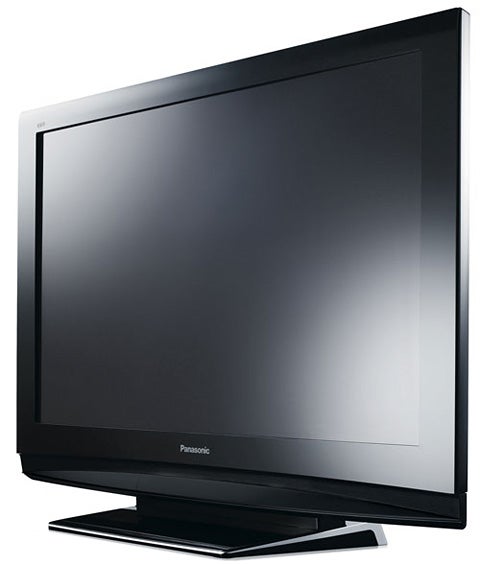
If you think about it, this kind of makes sense given the extra directness of the path between an incoming Freesat HD signal and its appearance on the 46PZ81’s screen. But it’s still very nice to see the theory turned into glorious HD practice, especially if you make sure you’ve got the TV’s Overscan feature deactivated.
For similar reasons it also seemed to my eyes that standard definition pictures looked slightly cleaner through the Panasonic’s own Freesat tuner than an external Freesat receiver box – but the difference here is only marginal.
In fact, the 46PZ81 proves an unusually canny operator when it comes to rescaling Freesat standard def pictures, adding less video noise than many rival Full HD TVs, and also doing a great job of reducing the noise inherent to the incoming broadcast signals.
This Freesat standard definition source noise is a touch annoying, in that there’s at least as much of it here as we see in a standard definition Freeview broadcast – the move to satellite’s greater bandwidth has not, it seems, had a positive effect. But this isn’t the fault of the Panasonic TV, which actually does its best to make the most of what it’s given.
Turning now to more general strengths of the 46PZ81’s pictures – not connected directly to its Freesat talents – we find some predictably awesome black levels. We’ve no idea, to be honest, if the deep, rich, greyness-free black levels on show during a run-through of ”The Prestige” on Blu-ray are representative of the boasted 1,000,000:1 contrast ratio. But we certainly can say that that they’re absolutely superb, add a huge amount of punch and dynamism to anything you watch, and clearly get deeper than any LCD TV seen to date.
It’s nice, too, to find precious little motion blur in the Panasonic’s pictures, again countering a problem commonly seen with rival LCD technology. What’s more, motion enjoys exceptional fluidity with the Intelligent Frame Creation system in play with, for the most part, only the rarest of processing ‘side effects’ to worry about. You might want to turn this feature off during sports viewing, as it can cause a little shimmer and flicker with extremely fast footage. But for most of the time it’s a seriously clever feature well worth leaving on.
Having just mentioned the lack of side effects from the IFC system, I’ll also add that the 46PZ81 remains impressively free of traditional plasma technology shortcomings, such as striped colour blends and dotting noise over motion.
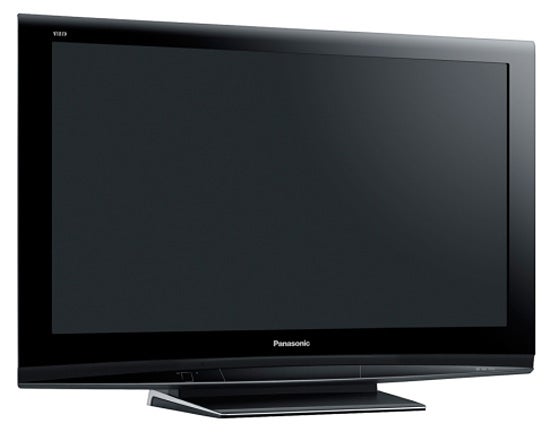
Colours are vibrant and eye-catching too – though the set’s colour handling also gives us our only ‘beef’ with its picture quality, which is that very occasionally, usually during darker scenes or with low-quality sources, the picture tone becomes just a touch over-influenced by orange or green.
Turning to the 46PZ81’s audio, we find a surprisingly high level of performance considering the set doesn’t employ Panasonic’s Advanced Smart Sound technology (with its separated tweeters and woofers). Voices are clear, rich and well locked to the screen, there’s a nice ‘spacious’ feel to the soundstage that stops even the opening Omaha Beach sequence of ”Saving Private Ryan” from sounding overcrowded, muddy or cramped; and there’s enough power to propel the sound around your room with real attack and aggression. There’s not as much depth or richness to bass as with Panasonic’s Advanced Smart Sound TVs, but compared with most ‘ordinary’ flat TVs, it sounds really rather good.
Verdict
Although it’s a shame for the 46PZ81 that the Freesat service doesn’t currently carry a bit more high definition content to make the most of its screen’s Full HD resolution, that’s hardly the TV’s fault. In fact, there’s very little that IS the TV’s fault. It’s yet another terrific Panasonic plasma TV that works impressively hard at getting the best from its groundbreaking new source – while also costing considerably less than you might have expected.
What’s more, it finally allows the Freesat name to be associated with a really high quality product from a well-respected brand rather than the mostly bargain-bucket brands shipping Freesat receiver boxes – and for that Freesat really ought to be very grateful indeed.
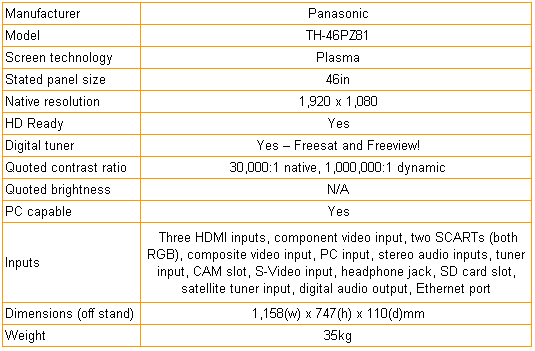
How we test televisions
We test every TV we review thoroughly over an extended period of time. We use industry standard tests to compare features properly. We’ll always tell you what we find. We never, ever, accept money to review a product.
Trusted Score
Score in detail
-
Features 10
-
Value 10
-
Image Quality 9
-
Design 8
-
Sound Quality 8

